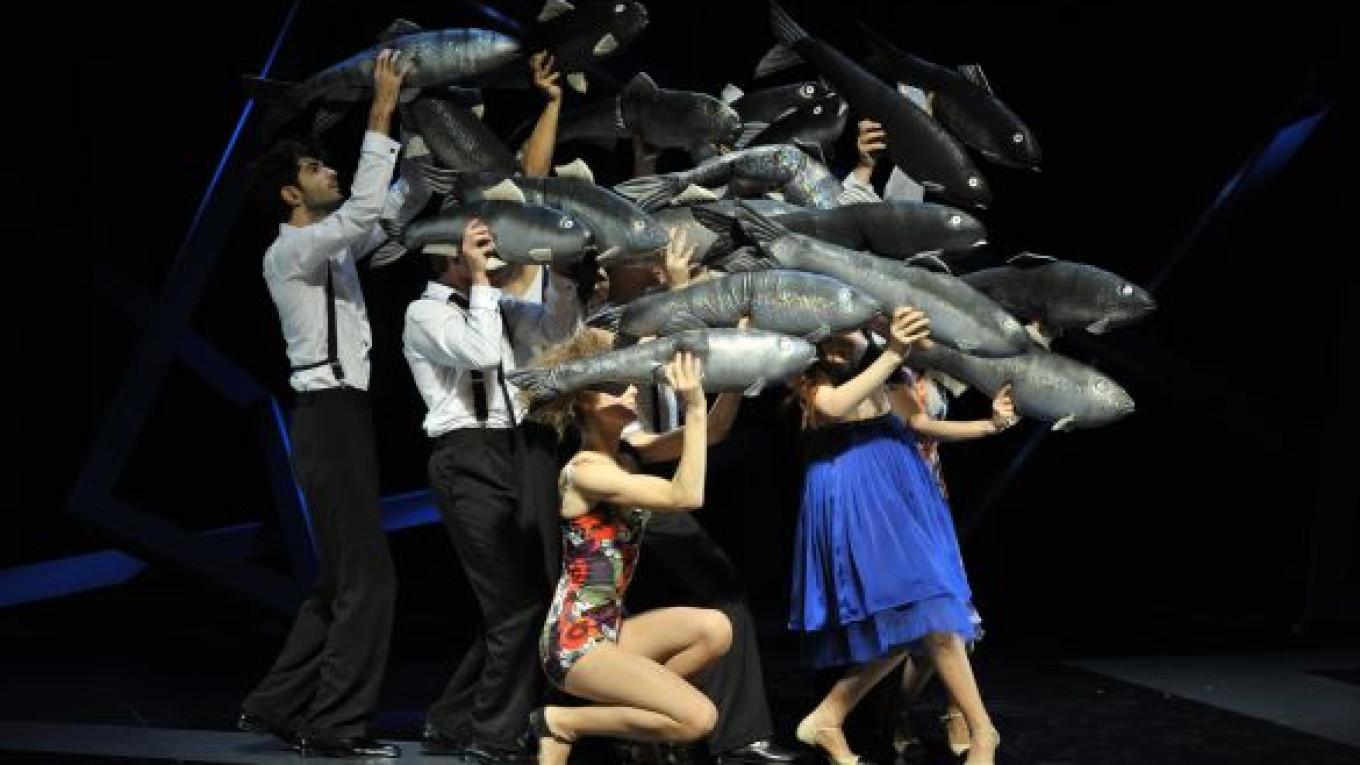There's nothing original in my saying that a production of "Sailors and Whores" at the Fomenko Studio is highly original. But it still deserves to be said.
Yevgeny Kamenkovich's dramatization of "The Gift" last fall was the first new production at the theater since the death of founder Pyotr Fomenko in August. But that show had long been in the works and so, surely, was never intended to signal a new direction for the theater.
"Sailors and Whores," the first show to be unveiled since Kamenkovich became artistic director in October, is. It is both a sign of a new direction and, in fact, a new direction for the theater.
Staged by choreographer Oleg Glushkov, it is purely a dance piece focusing on male-female relationships. The few words spoken throughout the evening are not intended to be anything more than a few funny sounds. Is this modern dance? It is not classical dance. For me, the show has the feel of a production by Pina Bausch or Sasha Waltz, both of whom took dance beyond the safe confines of generic boundaries.
One of the marvelous things about dance is that it supplants the need for language, both as a performance tool and in the sense that talking about it afterward often misses the point. It's a bit like asking a crate full of oranges to tell us what it might be like to be a crate full of apples.
Still, here I am, left with the task of attempting to communicate what I saw, heard and experienced during this beautiful performance.
It is often funny. Glushkov has a light touch in his work with actors and scenes, but he also doesn't shy away from the occasional loaded punch line. A young man kindly giving the gift of a fish to a grateful woman in the opening seconds of one segment grows into the hilarious and visually arresting image of the woman being swept up in a whole school of silvery, slithering fish.
It is often bracing, hinting at looming tragedy, as in a scene when a woman, left alone, casually drinks a cup of coffee, laughs and then forebodingly smears her lipstick over her cheeks.
The show is sexy, as in a segment when a row of some 12 to 14 bare female legs emerge from behind a suspended wall and dance and leap in unison. It becomes quite elegant when the women's legs are joined by those of men dressed in well-ironed black slacks. A hint of burlesque turns to a tuxedo ball in seconds.
Glushkov's choreography is thoughtful and whimsical. I was particularly amused by a scene in which men's heads fell affectionately onto their female partners' left shoulders. What begins as a tender moment quickly escalates into something else as the weight of the falling head causes the female dancer's torso to turn in such a way that her right shoulder spins and whacks the man's head, sending it careening off like a kicked ball.
It is a clever reminder that there are always just one or two unthinking gestures separating emotional intimacy from a total breakdown in communication.
The cast of eight men and seven women is a mix of the theater's young and veteran actors. Prominent among the women are the sisters Polina and Ksenia Kutepova, and their longtime partner Madlen Dzhabrailova.
To my knowledge, none of these actors had any special preparation that would make them ideal modern dancers, but they, like everyone in the cast, are entirely comfortable leaving behind the language of words for the language of motion.
Rarely, if ever, do you see Glushkov simplifying his choreographic ideas to suit performers not fully up to the task. This is a full-fledged dance piece in which everyone involved performs at the highest level.
Designer Alexei Kondratyev provides a nonspecific, attractively suggestive setting for the performance. Geometrical forms are moved about the stage, changing the space and providing obstacles or physical aids for the dancers. Lighting designer Vladislav Frolov seems to concentrate on the color blue and the use of light and shadow. Costume designer Irina Belousova provides plenty of flouncy style and color for the women and mostly understated chic for the men.
"Sailors and Whores" is an admirable and fascinating turn of events for the Fomenko Studio. It provides no basis of comparison whatsoever to the themes or aesthetics usually favored by Fomenko. It truly does take the theater in a new direction.
"Sailors and Whores" (Moryaki i Shlyukhi) plays Feb. 4, Feb. 13 and Feb. 26 at 7 p.m. at the Fomenko Studio, 29 Naberezhnaya Tarasa Shevchenko. Metro Kutuzovskaya. Tel. 499-249-1921. www.fomenko.theatre.ru. Running time: 2 hours, 30 minutes.
Related articles:
A Message from The Moscow Times:
Dear readers,
We are facing unprecedented challenges. Russia's Prosecutor General's Office has designated The Moscow Times as an "undesirable" organization, criminalizing our work and putting our staff at risk of prosecution. This follows our earlier unjust labeling as a "foreign agent."
These actions are direct attempts to silence independent journalism in Russia. The authorities claim our work "discredits the decisions of the Russian leadership." We see things differently: we strive to provide accurate, unbiased reporting on Russia.
We, the journalists of The Moscow Times, refuse to be silenced. But to continue our work, we need your help.
Your support, no matter how small, makes a world of difference. If you can, please support us monthly starting from just $2. It's quick to set up, and every contribution makes a significant impact.
By supporting The Moscow Times, you're defending open, independent journalism in the face of repression. Thank you for standing with us.
Remind me later.


